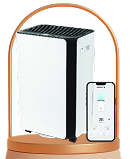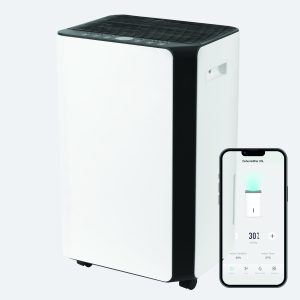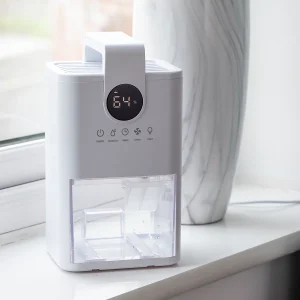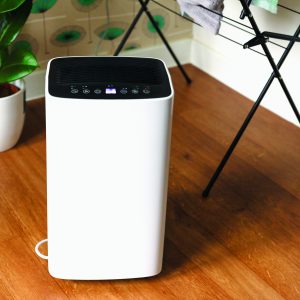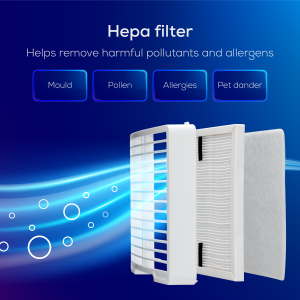Moisture in the home can lead to a host of problems—from mould and mildew to damaged furniture, musty odours, and discomfort. For homeowners looking to maintain a healthy, dry indoor environment, a desiccant dehumidifier offers an efficient, low-maintenance solution. In this guide, we will explore what makes these units unique, their key benefits, and how to choose the right one for your specific needs.
What is a desiccant dehumidifier?
A desiccant dehumidifier is a type of moisture-removal appliance that uses a desiccant—a material that absorbs water from the air—to reduce humidity levels. Unlike refrigerant dehumidifiers, which rely on condensation via cold coils, desiccant models work without any cooling process. This makes them particularly effective in environments with lower ambient temperatures.
The core of the system is a rotor or wheel that holds the desiccant (typically silica gel), which rotates continuously to draw in humid air and release dry air back into the room. The design allows for compact, quiet, and highly efficient moisture removal.
How does a desiccant dehumidifier work?
The working mechanism is actually quite simple. As the desiccant wheel rotates, moist air is pulled in and passed through a section of the wheel where the silica gel absorbs water vapour. The now dry air is released back into the room. At the same time, a separate airflow—heated via an internal element—is used to regenerate the desiccant material by drying it out. The extracted moisture is expelled as warm, damp air via an external outlet.
This continuous cycle means the unit can maintain optimal humidity levels without the risk of freezing, even in unheated spaces.
Key benefits of desiccant dehumidifiers
- Effective in low temperatures – Desiccant dehumidifiers perform reliably in environments as cold as -10°C to -20°C. They don’t rely on condensation, so they remain efficient even in unheated garages, lofts, or caravans. This makes them ideal for year-round use in colder climates.
- Quiet operation – With no noisy compressor, desiccant units operate with minimal sound, similar to a quiet fan. They’re perfect for bedrooms, offices, or any space where peace and quiet is valued. You can run them overnight without disruption.
- Portable and lightweight – Most desiccant models are compact and light, making them easy to move between rooms or floors. Many include handles or wheels for added convenience. This mobility is great for both temporary and seasonal use.
- No risk of freezing – Unlike refrigerant models, desiccant dehumidifiers won’t freeze up in low temperatures. They continue extracting moisture consistently, even in cold or unheated conditions. This ensures dependable performance throughout winter.
- Warmer air output – These units release slightly warmed air as a by-product of the drying process. This can help raise room temperature and speed up indoor laundry drying. It’s an added comfort during colder months.
Applications of desiccant dehumidifiers
Desiccant dehumidifiers are especially valuable for homeowners seeking effective moisture control in various parts of the home, particularly during colder months or in naturally damp spaces.
- Homes with poor insulation or cold spots – Older homes or properties with limited insulation often suffer from damp walls, condensation on windows, and musty odours in colder rooms. A desiccant dehumidifier works efficiently in these cooler conditions, helping maintain a healthier, drier indoor environment without the risk of freezing up.
- Laundry drying indoors – When drying clothes inside—especially during winter or in flats without outdoor space—moisture from fabrics can build up and lead to condensation and mould. Desiccant units not only remove the excess humidity but also emit gently warmed air, helping clothes dry faster and preventing damp build-up on walls and ceilings.
- Bedrooms and living areas – In frequently used rooms, excess humidity can affect comfort and sleep quality. A desiccant dehumidifier runs quietly in the background, improving air quality without disruptive noise—ideal for overnight use in bedrooms or family living areas.
- Lofts, basements, and under-stair storage – These tucked-away spaces are prone to moisture accumulation due to poor ventilation and temperature drops. Desiccant dehumidifiers provide reliable performance even in unheated areas, protecting stored items like furniture, clothing, seasonal decorations, or documents from mould and damp damage.
- Holiday homes or unoccupied properties – For second homes, holiday lets, or properties that sit empty for long periods, moisture control is essential to prevent mustiness and mould. Desiccant dehumidifiers offer a dependable solution in unheated interiors, giving peace of mind that the property will stay fresh and dry between visits.
How to choose the right one for your needs
- Room size – Check the manufacturer’s recommended coverage area (usually in square metres or cubic metres) to ensure the unit can handle the space. Undersized models may run constantly without reducing humidity effectively, while oversized ones may consume more energy than necessary. Always consider ceiling height and insulation when estimating room volume.
- Water removal rate – This is measured in litres per day and indicates how much moisture the unit can extract in 24 hours. Higher-capacity models are best for larger or damper areas, such as basements or laundry rooms. For typical bedroom or living room use, a moderate extraction rate is often sufficient.
- Noise level – If you’re placing the dehumidifier in a bedroom, study, or living area, opt for a unit with a low decibel (dB) rating—typically under 40–45 dB for quiet operation. Quieter models use gentle fans and are free from the mechanical hum of compressors. This ensures minimal disruption during sleep, work, or relaxation.
- Energy use – Desiccant dehumidifiers may use more energy per hour than refrigerant models, but they often run more efficiently in cold environments. Look for models with energy-saving features such as auto shut-off, humidistat control, eco mode, and programmable timers. These help reduce overall power consumption while maintaining comfort.
- Drainage options – Most units come with a water collection tank, but for continuous operation—such as in unattended areas or during laundry drying—choose a model with a hose outlet. This allows the water to drain directly into a sink or outflow pipe. It eliminates the need to empty the tank regularly and supports hassle-free, extended use.
- Portability – If you plan to move the dehumidifier between rooms or floors, check for ergonomic features like carry handles, caster wheels, or a lightweight build. Portability is especially useful in multi-use homes or shared living arrangements. It also makes storage simpler during seasons when the unit isn’t in use.
Final thoughts
Whether you’re tackling damp bedrooms, drying laundry indoors, or safeguarding your holiday home during the off-season, a desiccant dehumidifier can be an excellent investment. Its ability to work quietly and efficiently in cold conditions sets it apart from other types of dehumidifiers. With the right model, you can enjoy a more comfortable, healthier living space without the hassle of manual moisture control. Take time to assess your space, usage patterns, and features that matter most—your ideal solution might just be a desiccant away.


